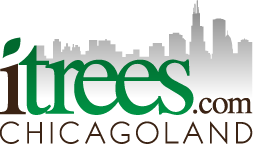Looking for help?
Find answers to your questions
Selecting the Right Area for Your Tree
Table of Contents
After you've identified the features you are looking for in a tree, here are our suggestions for what trees work best in certain areas of the yard.
Backyard
- Patio/Deck:
This area of your yard is very important. It is where you spend time relaxing and enjoying your yard with friends and family. Smart tree placement and choices can greatly add to your experience while in this space. First, think about the sun. What direction is the sun when you are most in this space? Add a tree in that area to provide you with shade. Next, think about neighbors. Which side of your patio or deck could you use the most privacy? Add a clump tree in that area. You do not need to surround your deck/patio with vegetation, but a few key trees in the right spot will make a world of difference. Place the privacy tree about 4-6' off the deck/patio. By adding a focal point close to the deck/patio, you keep attention close rather than looking past into your neighboring yards. If you haven't built your patio or deck yet, you can still plan ahead and get some trees growing in the spots you know you will need them. - Property Lines:
Trees in these areas can add privacy, interest, and beauty to your back yard. Resist the temptation to put too many trees along the property lines—their growth may cause overcrowding. You also don't have to line the entire property to get a boundary effect. Simply add a few groupings of trees in 2 or 3 key areas, and you can achieve the effect you want. Trees can be all mulched together in one large planting bed, or separately within the grass. Another good idea is to mix the varieties. Maybe plant a group of 2 evergreens and 2 birch, or 1 crab, 1 birch, and 1 evergreen. You could even make a grouping of 2 evergreen and 1 shade tree. The possibilities are endless! - Back Yard Open Space:
The open space in your back yard is priceless. This is where the kids play or you might have a vegetable garden. It also provides open green space to set off your other planting areas. How many shade trees you add here depends on the size of your yard. Use your best judgment and place trees where you need accent or shade. Add a shade tree near your children's play area for fun and shade. Do not put a tree where it will shade your vegetable garden. Adding short ornamental trees might block your view to other areas of the yard.
Front Yard
- Parkway:
The parkway should have shade trees only. It is not recommended to use evergreens, clump form trees, or short ornamental trees in the parkway. These trees do not allow for a good line of sight to the front of the house, or for cars backing out of the drive. Parkway trees should be trees that reach at least 30' in height or greater. Place trees in the middle of the parkway, at least 15-20' apart from each other. Usually homes have 2 or more parkway trees. - Front Open Space:
The front yard open space is a good area to showcase trees. Most average yards in a subdivision have room for 2-3 trees in these areas. Some yards have room on the opposite side of the yard from the front door too. The trees in these areas should coordinate with the parkway and front landscape trees. Design principles generally suggest placing trees about the open space randomly. Again, leave ample room between trees for their canopy to spread as they grow. - Front Landscape:
The front landscape area is the area around the house where the bushes and flowers will be. This area should include a few trees, usually of the small ornamental size. Many times a tree is placed off the corner of the house to "anchor" the planting bed. This tree should be at least 12-15' out from the house. Many times designers will add another smaller tree along the sidewalk or by the garage corner to add another level to the design.
Side Yard
- Side Yard:
The side yards are located on both sides of your house. Your landscaping needs here change dramatically based on the size of your house lot. Small house lots may only be able to fit a few ornamental trees, while large house lots leave a lot of room for windbreaks, and property line plantings.The side yards are usually narrower than other parts of the yard. These areas, depending on your lot size, should be designed carefully. Many times placing a shade tree in these areas will benefit your home by shading and cooling it. If the space is narrow, think about the upright ornamental pear. It only gets about 15-20' wide with a max height of around 35', so it would be a good choice for a narrow side yard.
Large lots provide an opportunity to really set your house apart. Orchards, windbreaks, and other large trees planted in rows can really frame your house and property.

